#staten island museum
Explore tagged Tumblr posts
Text


1 note
·
View note
Text
Deco Doings - October, 2023
Autumn by William Welsh, 1930. Image from Pinterest. Here are some Art Deco events to partake during October. Metropolitan Museum of Art Art for the Millions: American Culture and Politics in the 1930s (In Person Event) Thursday, September 7 – Sunday, December 10, 2023, Metropolitan Museum of Art, 1000 Fifth Avenue, New York, NY Ida York Abelman (American, New York 1910–2002)Man and Machine,…
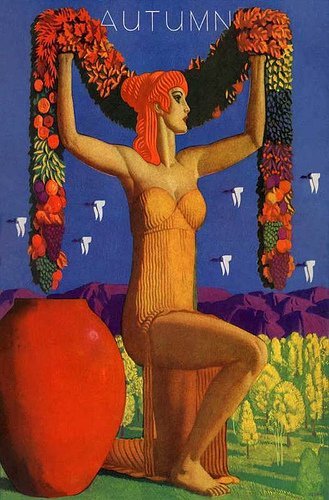
View On WordPress
#1920&039;s London Night Life#Art Deco Museum#Art Deco Society of California#Art Deco Society of Chicago#Art Deco Society of Los Angeles#Art Deco Society of New York#Art Deco Society of the UK#Art Deco Society of Washington#Art Deco Sunnyside#Avant-Garde Posters#Green Mill Cocktail Lounge#Hildreth Meiere#Hollywood Forever Cemetery#Miami Preservation League#Poster House#Queens New York#Staten Island New York#Tutmania#Ursula Parrott#Vintage Clothing#Vintage Cocktails#Vintage Radio
1 note
·
View note
Text
"Chicago’s 82-story Aqua Tower appears to flutter with the wind. Its unusual, undulating facade has made it one of the most unique features of Chicago’s skyline, distinct from the many right-angled glass towers that surround it.
In designing it, the architect Jeanne Gang thought not only about how humans would see it, dancing against the sky, but also how it would look to the birds who fly past. The irregularity of the building’s face allows birds to see it more clearly and avoid fatal collisions. “It’s kind of designed to work for both humans and birds,” she said.
As many as 1 billion birds in the US die in building collisions each year. And Chicago, which sits along the Mississippi Flyway, one of the four major north-south migration routes, is among the riskiest places for birds. This year, at least 1,000 birds died in one day from colliding with a single glass-covered building. In New York, which lies along the Atlantic Flyway, hundreds of species traverse the skyline and tens of thousands die each year.
As awareness grows of the dangers posed by glistening towers and bright lights, architects are starting to reimagine city skylines to design buildings that are both aesthetically daring and bird-safe.
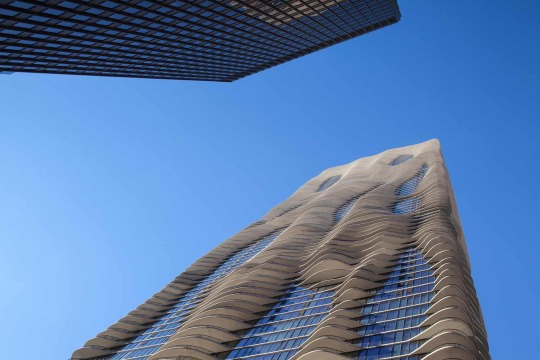
Pictured: Chicago's Aqua Tower was designed with birds in mind.
Some are experimenting with new types of patterned or coated glass that birds can see. Others are rethinking glass towers entirely, experimenting with exteriors that use wood, concrete or steel rods. Blurring lines between the indoors and outdoors, some architects are creating green roofs and facades, inviting birds to nest within the building.
“Many people think about bird-friendly design as yet another limitation on buildings, yet another requirement,” said Dan Piselli, director of sustainability at the New York-based architecture firm FXCollaborative. “But there are so many design-forward buildings that perfectly exemplify that this doesn’t have to limit your design, your freedom.”
How modern buildings put birds in danger
For Deborah Laurel, principal in the firm Prendergast Laurel Architects, the realization came a couple of decades ago. She was up for an award for her firm’s renovation of the Staten Island Children’s Museum when the museum’s director mentioned to her that a number of birds had been crashing into the new addition. “I was horrified,” she said.
She embarked on a frenzy of research to learn more about bird collisions. After several years of investigation, she found there was little in the way of practical tips for architects, and she teamed up with the conservation group NYC Audubon, to develop a bird-safe building guide.
The issue, she discovered, was that technological and architectural advancements over the last half-century had in some ways transformed New York City – and most other US skylines and suburbs – into death traps for birds...
At certain times of day, tall glass towers almost blend into the sky. At other times, windows appear so pristinely clear that they are imperceptible to birds, who might try to fly though them. During the day, trees and greenery reflected on shiny building facades can trick birds, whereas at night, brightly lit buildings can confuse and bewilder them...

Pictured: A green roof on the Javits Convention Center serves as a sanctuary for birds.
The changes that could save avian lives
About a decade ago, Piselli’s firm worked on a half-billion-dollar renovation of New York’s Jacob K Javits Convention Center, a gleaming glass-clad space frame structure that was killing 4,000-5,000 birds a year. “The building was this black Death Star in the urban landscape,” Piselli said.
To make it more bird friendly, FXCollaborative (which was then called FXFowle) reduced the amount of glass and replaced the rest of it with fritted glass, which has a ceramic pattern baked into it. Tiny, textured dots on the glass are barely perceptible to people – but birds can see them. The fritted glass can also help reduce heat from the sun, keeping the building cooler and lowering air conditioning costs. “This became kind of the poster child for bird-friendly design in the last decade,” Piselli said.
The renovation also included a green roof, monitored by the NYC Audubon. The roof now serves as a sanctuary for several species of birds, including a colony of herring gulls. Living roofs have since become popular in New York and other major cities, in an inversion of the decades-long practice of fortifying buildings with anti-bird spikes. In the Netherlands, the facade of the World Wildlife Fund headquarters, a futuristic structure that looks like an undulating blob of mercury, contains nest boxes and spaces for birds and bats to live.
The use of fritted glass has also become more common as a way to save the birds and energy.
Earlier this year, Azadeh Omidfar Sawyer, an assistant professor in building technology in the Carnegie Mellon School of Architecture, working with student researchers, used open-source software to help designers create bespoke, bird-friendly glass patterns. A book of 50 patterns that Sawyer published recently includes intricate geometric lattices and abstract arrays of lines and blobs. “Any architect can pick up this book and choose a pattern they like, or they can customize it,” she said.
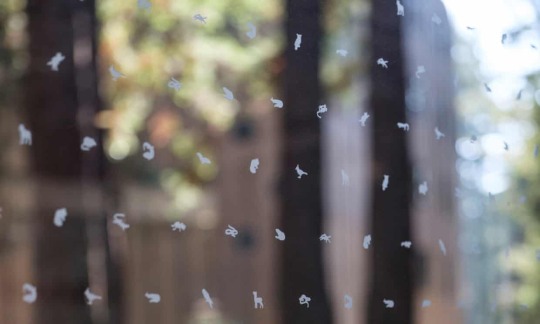
Pictured: The fritted glass used in Studio Gang’s expansion of Kresge College at the University of California, Santa Cruz, depicts the animals in the local ecosystem.
Builders have also been experimenting with UV-printed patterns, which are invisible to humans but perceptible to most birds. At night, conservationists and architects are encouraging buildings turn off lights, especially during migration season, when the bright glow of a city skyline can disorient birds.
And architects are increasingly integrating screens or grates that provide shade as well as visibility for birds. The 52-floor New York Times building, for example, uses fritted glass clad with ceramic rods. The spacing between the rods increases toward the top of the building, to give the impression that the building is dissolving into the sky.
Gang’s work has incorporated structures that can also serve as blinds for birders, or perches from which to observe nature. A theater she designed in Glencoe, Illinois, for example, is surrounded by a walking path made of a wood lattice, where visitors can feel like they’re up in the canopy of trees.

Pictured: The Writers Theatre, designed by Studio Gang, includes a walking path encased in wood lattice.
Rejecting the idea of the iridescent, entirely mirrored-glass building, “where you can’t tell the difference between the habitat and the sky”, Gang aims for the opposite. “I always tried to make the buildings more visible with light and shadow and geometry, to have more of a solid presence,” she said.
Gang has been experimenting with adding bird feeders around her own home in an effort to reduce collisions with windows, and she encourages other homeowners to do the same.
“I’ve found that birds slow down and stop at feeders instead of trying to fly through the glass,” she said.
While high-rise buildings and massive urban projects receive the most attention, homes and low-rise buildings account for most bird collision deaths. “The huge challenge is that glass is everywhere.” said Christine Sheppard, who directs the glass collisions program at the American Bird Conservancy (ABC). “It’s hard to know what I know and not cringe when I look at it.”
Tips for improving your own home include using stained glass or patterned decals that can help birds see a window, she said. ABC has compiled a list of window treatments and materials, ranked by how bird-safe they are.
Whether they’re large or small, the challenge of designing buildings that are safe for birds can be “liberating”, said Gang, who has become an avid birdwatcher and now carries a pair of binoculars on her morning jogs. “It gives you another dimension to try to imagine.”"
-via The Guardian, December 27, 2023
#conservation#birds#avian#ornithology#new york city#chicago#united states#architecture#green architecture#conservation biology#construction#sustainability#glass#glass windows#skyscraper#cityscape#buildings#bird conservation#birdwatching#good news#hope#“hey mc why is this post so in depth and full of pics compared to what you usually post” you ask#great question#the answer is bc I like architecture a lot#...well I like the kinds of architecture I like a lot lol#bauhaus can fight me tbh#but sustainable architecture is awesome#also this article actually came with a bunch of pics#which yknow most of them don't#cw animal death
1K notes
·
View notes
Text
Okay, serious discussion about s5e7 of wwdits. I have a lot of mixed feelings about it. The creatures fell into the uncanny valley, why did they choose the donut lady as a plot for nadja when it could've been with the guide, etc. HOWEVER, what I do appreciate about this episode is the meta commentary on how Nandor's culture is simultaneously erased in history classes and then mocked by museums. His culture, his writings, his garments.. almost everything about his history is completely misrepresented by the museum and all of his artifacts were stolen. He literally sees a pair of his underwear on display! He is looked at as an object, a relic of the past. The museum portays him as being unintelligent and frowns upon his writings. And that's based on their narrow understanding of him, Al Q, and his culture. The historians do not know Nandor of course, but they view him through a lense that chooses to only see him and his culture as unintelligent, subhuman even- because why else would someone write something like this? Or wear something like this? Or use weapons like this? It reminds me of those TV shows that theorize the pyramids were made by aliens. Because how else could the Egyptians have been capable of creating the pyramids? Surely they can't be intelligent enough! *eye roll*
Idk someone could probably use better words to communicate what I'm trying to say here, but I wanted to bring it to the table anyway. Oh, also Colin becomes the center of attention by acting like the stereotypical white professor who is more focused on feeding their ego than actually educating his pupils. And this ends up in Nandor being pushed out of the conversation. A literal metaphor for how whiteness obscures and diminishes other cultures and immigrant communities. Of course Colin did that just to feed off of the students. Because then he ends up replacing the museum display with a more accurate representation of Nandor (albeit for comedic effect). And then by taking back his horsie necklace. But.. everyone listened to Colin! And ignored Nandor! Lots to think about in terms of erasure, white washing, forced assimilation, how museums profit off of stolen artifacts and skewing history, etc.
Nandor is an immigrant to Staten island and he was forced to assimilate. Imagine how he must feel when he sees all these stolen artifacts in the museum, and plaques that inaccurately portray his culture and history. And people gawking at the clothes and weapons he proudly wore/still wears. This is a reality for many native and immigrant communities here in America and abroad. Being forced to view your culture, your way of life through the lense of the oppressor.
#maybe im being too meta but i appreciate the writers for pointing out how museums/professors/institutions profit off stolen artifacts#and profit off of minimizing/erasing other cultures in a way that benefits whiteness#ultimately colin was an ally to nandor by fixing the museum so that it accurately portrayed Nandor#and by taking back his stolen horsie necklace. big win for the colin/nandor arc#wwdits#wwdits spoilers#what we do in the shadows#its a funny show! i know. just. let me sit with my thoughts lol
1K notes
·
View notes
Text
#felt KINDA unprepared last year and i am still very unprepared#i might make a few buttons or something idk
ok i've decided not to stress out about it because this year has been really hectic for me and i don't have the spoons required right now to think about this
but irregardless, concepts for public transit stickers feat. east blue sides:

love the last minute approval i recieved for anyc but i'll be there! (not artist alley im there for other reasons)
#one piece#luffy#zoro#usopp#nami#sanji#i think robin would be eastern parkway-bk museum#franky is the staten island ferry#chopper is w farms-e tremont sq#brook church ave on the g line#jinbe rockaway beach#these are probably spelled wrong but eh w/e
6 notes
·
View notes
Text

16th century Follower of Pontormo - Portrait of a Lady
(Staten Island Museum)
87 notes
·
View notes
Text
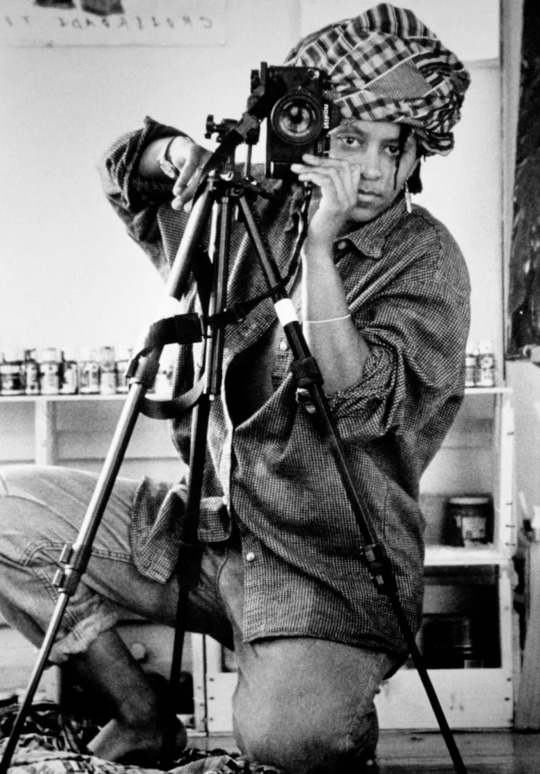
Jean Weisinger spent much of the 1990s capturing intimate portraits of revolutionary Black women — Audre Lorde, Alice Walker, Angela Davis, and Assata Shakur among them — and impromptu photographs of people she met in her travels across the United States. Almost none of the artist’s work made its way into museum collections or gallery exhibitions, but from the tiny Alice Austen House in Staten Island, Executive Director Victoria Munro has spent the past two and a half years developing Weisinger’s unrevealed photographs and meticulously documenting the histories behind each one of them.
#jean weisinger#art#photography#audre lorde#alice walker#angela davis#assata shakur#alice austen house
763 notes
·
View notes
Text
what's also funny abt Nandor's character is that, supposedly, he was a really big deal in his time, but none of that survived into legend. like, this whole legacy that he's so proud of is completely wiped out. no stories survived of his epic tyranny and conquests, no History Channel documentaries talk abt him or internet conspiracy theories of where he disappeared to.
imagine it was Alexander the Great's diary just hanging out at the Staten Island Heritage Museum of all places, with a plaque that said, 'This dweeb was a scared virgin who never accomplished anything'.
hilarious.
#wwdits#what we do in the shadows#nandor#nandor the relentless#and alexander would have deserved it#nandor must have forgotten to erect monuments other than his peen#i just want one history nerd to have nandor as their special interest ok#someone out there must have written at least a college dissertation#my meta#wwdits meta
199 notes
·
View notes
Photo

New York City
New York tumblr more photos here New York City, often simply referred to as NYC, is one of the most iconic and vibrant cities in the world. Located in the northeastern part of the United States, it is situated on the southeastern tip of the state of New York. With a population of over 8 million residents within the city limits and over 20 million in the greater metropolitan area, it is the most populous city in the United States.
Geography and Layout: New York City is composed of five boroughs: Manhattan, Brooklyn, Queens, The Bronx, and Staten Island. The city is located on a series of islands and connected by bridges and tunnels. Manhattan, the heart of the city, is where many of its most famous landmarks are located. It is divided into several neighborhoods, each with its own distinct character and atmosphere. The city is known for its impressive skyline, dominated by iconic skyscrapers like the Empire State Building, One World Trade Center (Freedom Tower), and the Chrysler Building.
Culture and Diversity: One of New York City's defining characteristics is its incredible diversity. People from all over the world have made the city their home, resulting in a rich tapestry of cultures, languages, cuisines, and traditions. This diversity is celebrated through various cultural events, festivals, and neighborhoods that showcase the heritage of different communities.
The city's cultural scene is unparalleled, with world-class museums such as the Metropolitan Museum of Art, the Museum of Modern Art (MoMA), and the American Museum of Natural History. Broadway, located in the Theater District of Manhattan, is synonymous with American theater and is famous for its top-tier productions.
Economy and Business: New York City is a global economic powerhouse. Its financial district, centered around Wall Street in Lower Manhattan, is home to some of the world's largest and most influential financial institutions. The city's economy is incredibly diverse, encompassing finance, media, technology, fashion, tourism, and more.
Education and Research: The city boasts some of the world's most prestigious universities, including Columbia University, New York University (NYU), and The City University of New York (CUNY) system. These institutions contribute to the city's reputation as a hub for research, innovation, and intellectual exchange.
Cuisine and Culinary Scene: New York City is a culinary melting pot, offering an array of dining options that reflect its multicultural makeup. From street food carts offering hot dogs and pretzels to high-end restaurants serving international cuisines, the city caters to all tastes and budgets. Iconic foods like New York-style pizza, bagels, and deli sandwiches are part of the city's culinary fabric.
Transportation: The city's extensive public transportation system, which includes the subway, buses, and ferries, is a crucial part of daily life for millions of residents and visitors. The yellow taxi cabs are also an iconic symbol of the city's transportation.
Landmarks and Attractions: New York City is home to an impressive array of landmarks and attractions. Some of the must-visit places include:
Times Square: A bustling commercial and entertainment hub known for its bright lights, theaters, and New Year's Eve celebrations.
Central Park: An expansive green oasis in the heart of Manhattan, offering a retreat from the urban hustle and bustle.
Statue of Liberty and Ellis Island: Iconic symbols of American freedom and immigration history.
Brooklyn Bridge: A historic suspension bridge connecting Manhattan and Brooklyn, offering stunning views of the city skyline.
Rockefeller Center: A complex of commercial buildings, famous for its ice-skating rink and the Top of the Rock observation deck.
The High Line: A unique elevated park built on a former railway track, offering a serene escape above the city streets.
Museums and Art Galleries: In addition to the aforementioned museums, NYC is home to the Guggenheim Museum, Whitney Museum of American Art, and more.
Challenges and Opportunities: Despite its allure, New York City also faces challenges such as high living costs, traffic congestion, and issues related to affordable housing. The city has shown resilience in the face of challenges, and initiatives are continually being developed to address these concerns and create a more equitable and sustainable future.
In summary, New York City is a dynamic and multifaceted metropolis that captivates visitors and residents alike with its cultural richness, economic vitality, and unparalleled energy. Its ability to constantly reinvent itself while honoring its history makes it a truly remarkable and enduring global city.
#New York City#new york#newyork#New-York#nyc#NY#Manhattan#urban#city#USA#United States#buildings#travel#journey#outdoors#street#architecture#visit-new-york.tumblr.com
152 notes
·
View notes
Text
Been thinking a lot.
I have become very tired of my museum job. They promised me that I’d be going full time for months but it keeps getting pushed back so apparently I’m going full time in April. They’ve done some things recently that have made me no longer happy to work there like cut hours so badly + without warning that I’m struggling to make rent this month. There’s a constant feeling that your coworkers are watching you to see if you make a mistake so they can report you and make themselves look better. It’s a lot of politics and responsibility that does not line up with the kind of pay I get.
With my other job I am in the heart of Boston every week and it made me realize how much I really miss living in a city, as I currently live in the suburbs. The rent in the suburbs of Boston is insane. Boston rent is equally insane and neither place really has any studio apartments within my budget. Can’t have roommates for reasons people are familiar with my blog can probably figure out. If I went full time at the museum I could probably stay in my current place, but right now 75% of my income goes to rent. I was already planning on trying to find something cheaper if possible because I would like to be able to spend money on things other than rent and groceries I can’t keep using my credit card to pay insurance co-pays.
The art scene in Boston is incompatible with my work. I am only getting shows through connections I made in art school, and I keep having conversations with curators about the venues needing work that’s “accessible” to a non-art going audience (read: not a penis with a tumor, the current thing on my easel after reading about how bestiality causes an increased risk of genital cancers isn’t that fascinating?) so I’m really only showing the work I made while in undergrad where I was afraid to like. Make the worst images.
I had that artist talk i gave to my mentor’s class and got to reconnect afterwards and it was wonderful and I felt so encouraged afterwards. He asked when I was moving to New York. He knows I’m from nyc originally and that I do plan to return there. And I went “oh yknow for grad school. I’m trying to move into Boston right now” and he was just like “You should really just move to New York” and like. He’s not wrong.
Like every time I’ve gotten upset about my life in the past 6 months I’ve scrolled through NY Craigslist apartments. They’re so much cheaper than Boston and the lower end fits comfortably in my budget. I could just find a tiny shitty thing in Staten Island.
But it’s such a big move??? Like am I ready to uproot my life like that again? Like I could just stick it out another year and see how being full time at the museum treats me and stay in this apartment for another year. My art practice won’t magically get any more support but still. I don’t know :( I’m very torn.
7 notes
·
View notes
Text
#TwoForTuesday :



William Zorach (USA, b. Lithuania, 1889-1966)
Pumas, 1948
Plaster with paint & coating
On display at University of Delaware Museums’ new exhibit “Sight, Sound, and Motion: The Dimensions of Sculpture”
“Animals, and particularly cats, were among William Zorach's favorite subjects. This pair of sculptures was inspired by two pumas that lived at the Staten Island Zoo. Zorach studied and drew them for a week in preparation for producing the sculptures. These plaster models were produced to make the molds used to cast the sculptures in bronze. Surface residue and abrasions indicate that these plasters were used in the foundry. Following the casting process, they were returned to Zorach, who painted them to look like bronze. Six bronze casts were created of the pumas, including a pair in the National Gallery of Art in Washington, DC. A related Puma made in Labrador black granite in 1954 was installed in Fairmount Park in Philadelphia in 1962.”
#animals in art#20th century art#museum visit#sculpture#pair#Two for Tuesday#Puma#wild cats#felines#William Zorach#modern art#American art#exhibiton#UD Museums#1940s
17 notes
·
View notes
Note
hellllooo hows the new york (girl who cares very deeply that people have a good time in her city)
I’M BACK TODAY!!! And it was so fun!! It was a missions trip so I was primarily doing that (serving at food pantries, cleaning, prayer walking, etc.) But we had a free day where we went to the Natural History Museum (we were there for three hours!! It was life changing!!) Central Park (such a beautiful space!!) Times Square (I got to see ads for my fav shows on Broadway rn, decrying that I couldn’t go to a show but YKNOW STILL FUN) and then we took the Staten Island Ferry!! The ocean breeze was amazing ☺️☺️
Plus I loved the Subway SOOOO much. I don’t really have transit like that in my home city so it was so cool!!! I went on it like everyday so dope. ALSO ADKDJSHA THE FOOD WAS SO GOOD. I HAD THE BEST BAGEL I’VE HAD IN MY LIFE
Also just love the city in general!! It was my first time actually walking in NYC and woo! So great. It was epic. You live in a great city.
12 notes
·
View notes
Text
@newyorkbegins New York City, often referred to as NYC, is one of the most iconic and dynamic cities in the world. Here are some key highlights:
Geography and Layout
Boroughs: NYC is composed of five boroughs: Manhattan, Brooklyn, Queens, The Bronx, and Staten Island.
Landmarks: Famous landmarks include the Statue of Liberty, Central Park, Times Square, and the Empire State Building.
Culture and Entertainment
Broadway: Known for its theater district, NYC is a global hub for Broadway shows.
Museums: Renowned museums such as the Metropolitan Museum of Art, the Museum of Modern Art (MoMA), and the American Museum of Natural History.
Music and Arts: A rich history of music, from jazz in Harlem to the punk scene in the East Village.
Food
Cuisine: NYC offers diverse culinary experiences, from street food like hot dogs and pretzels to high-end dining. It’s famous for its bagels, pizza, and cheesecake.
Ethnic Neighborhoods: Areas like Chinatown, Little Italy, and Koreatown offer authentic cultural dining experiences.
Economy
Financial Hub: Home to Wall Street, NYC is a major financial center globally.
Industries: Besides finance, key industries include media, fashion, technology, and healthcare.
Transportation
Subway: The NYC Subway is one of the largest and most extensive public transportation systems in the world.
Yellow Cabs: Iconic yellow taxis are a ubiquitous sight in the city.
Airports: Served by three major airports: JFK, LaGuardia, and Newark Liberty International.
Neighborhoods
Diversity: Each borough and neighborhood has its own unique character. Notable neighborhoods include Greenwich Village, Harlem, Williamsburg, and Astoria.
Residential Areas: Areas like the Upper East Side and Park Slope are known for their residential appeal.
Events and Festivals
New Year’s Eve: The Times Square Ball Drop is a globally recognized event.
Parades: Includes the Macy's Thanksgiving Day Parade, the NYC Pride March, and the St. Patrick's Day Parade.
History
Founding: Originally settled by the Dutch as New Amsterdam in the 17th century, it was later taken over by the British and renamed New York.
📽 @newyorkbegins
4 notes
·
View notes
Text
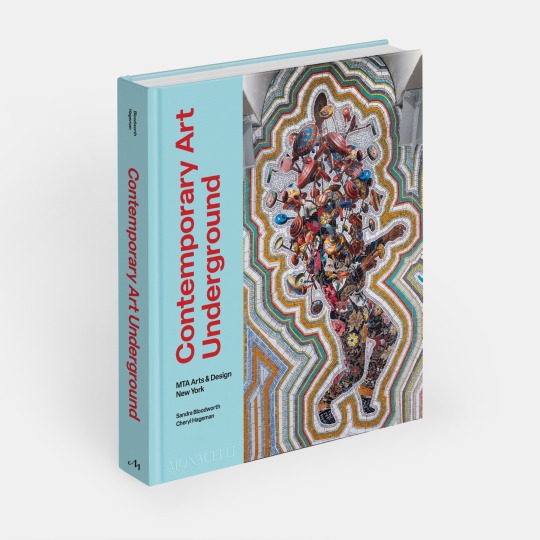
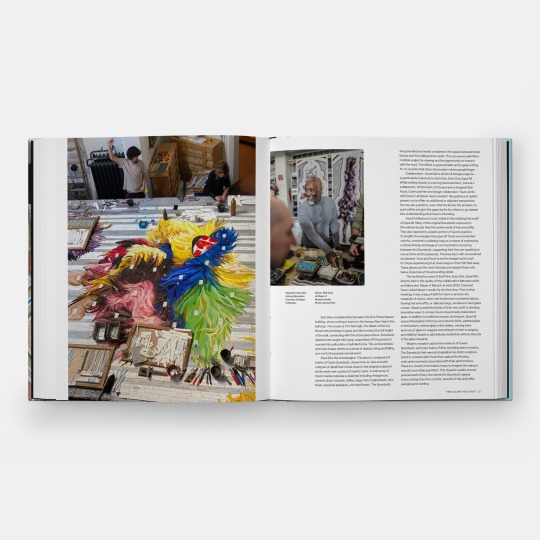
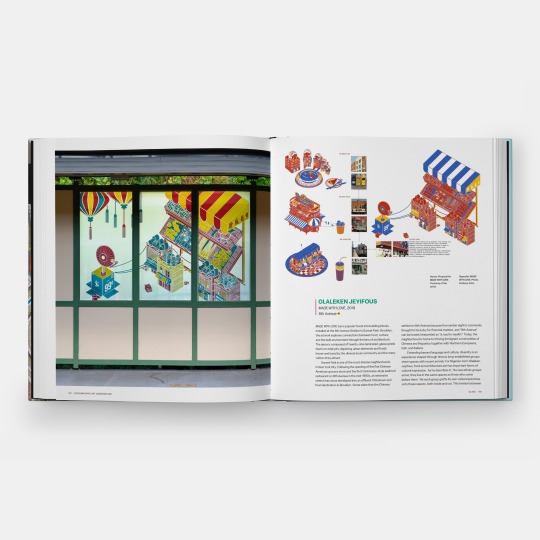

It is our great pleasure to announce that “Contemporary Art Underground,” a new book by MTA Arts & Design director Sandra Bloodworth and deputy director Cheryl Hageman, will hit the shelves this April!
The book is a celebration of the more than 100 #MTAArt works completed between 2015 and 2023. The Arts & Design collection has made museum-quality experiences part of the daily commute for NYCT, MNR, and LIRR riders. Focused on MTA Arts & Design’s most recent projects, “Contemporary Art Underground” is an exploration of the collaborative process behind this collection (now with nearly 400 permanent projects!) – from artist selection through the translation of original artwork into a site-specific installation – including proposal images, behind-the-scenes insights, and lots of photographs.
Take the journey with us across the city’s boroughs, from Manhattan and Queens to the Bronx, Brooklyn, Staten Island, and beyond. Learn how art in MTA stations and reconstruction initiatives uniquely engages with and informs its surroundings. View the fabrication of art in materials chosen for their resilience in the transit environment. Discover new appreciation for these incredible artworks and a diverse collection that has become symbolic of New York City.
#ContemporaryArtUnderground is available for pre-order now! https://www.phaidon.com/monacelli/art-and-photography/contemporary-art-underground-mta-arts-and-design-new-york-9781580936422/
13 notes
·
View notes
Text
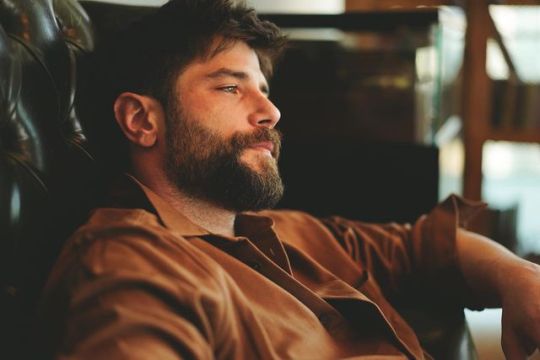
Oh, is that DEVRAN SAHIN? I heard the THIRTY-SIX year old is COURAGEOUS. But don’t let that pretty face fool you, they are also EGOTISTICAL. Makes sense seeing how they are a LEADER in THE SOCIETY.
wc. pinterest.
Basics.
full name: Devran Fadel Sahin nickname(s): Dev age: Thirty-Six birthdate: July 26th star sign: Leo gender: Cismale pronouns: He/Him sexuality: Bisexual Birthplace: Staten Island, NY current residence: Staten Island, NY languages: Turkish, English, Spanish, and some French.
Reflection.
face claim: berk cankat hair color: chestnut brown eye color: light brown height: 6’0” build: lean, athletic build tattoos: a large compass on his right shoulder scars: too many to keep track of
Personality.
characteristics: ambitious, fearless, confident, arrogant, stubborn, creative, sweet talker, pretentious, self-absorbed, selfish, energetic, persistent, supportive, demanding, socially active, egoistic, responsible, the perfectionist, ready to take challenges, possessive fears: failure and decaf coffee passions/hobbies: painting, drawing, baseball, lock picking, origami, collecting and restoring vintage cars, kickboxing, feeding the birds in the park, golf, tennis, and target practice character inspo: tony stark (iron man), bruce wayne (the dark knight), jordan belfort (wolf of wall street), logan huntzberger (gilmore girls), lando calrissian (star wars) drugs/ alcohol/ smoking: yes / yes / no colors: a combination of classic neutrals, black, navy, charcoal, and rich jewel tones: emerald green, royal blue, and a deep burgundy.
Backstory.
Devran Şahin was born with the weight of a legacy on his shoulders. As the firstborn son of Ahmet Şahin, the infamous leader of the Society—a New York-based syndicate renowned for its mastery of art heists and elaborate thefts—Devran’s future was set in stone. From an early age, he was groomed to one day take the reins of his father’s empire. But being the heir to such an empire wasn’t simply a privilege; it was a burden.
The Golden Son
Growing up in the lap of luxury, Devran had everything that money could buy. He attended the finest schools and spent weekends cruising through exclusive parties with his charming smile, tousled hair, and a reputation as the ultimate trust-fund playboy. To the outside world, Devran was the golden child—charming, carefree, and always the center of attention at New York’s most elite gatherings. He was a man of paradoxes: polished and graceful by day, a reckless adventurer by night. Yet, beneath the surface of high society’s glittering veneer, Devran was being carefully shaped for a very different kind of future. His father, Ahmet, had a singular vision for his son. He was to inherit the Society, yes, but only if he proved worthy. There was no room for weakness, no space for indulgence. Devran’s upbringing wasn’t filled with soft lessons of privilege; instead, it was a strict training regimen that taught him the art of manipulation, the power of charm, and the precision needed to execute high-profile heists without leaving a trace. While his classmates were focused on getting into Ivy League schools, Devran was absorbing blueprints of art museums, studying security systems, mastering sleight-of-hand techniques, and learning how to read people like an open book. Every lesson was designed to sharpen his mind and prepare him for the world of shadows and deceit that ran beneath the glittering surface of New York.
There was a time, however, when Devran considered escaping the life his father had planned for him. He dreamt of running away with his lover, starting fresh somewhere far from the shadows of his family’s empire. But his father swiftly put an end to that idea—and the relationship—when he found out. "You will not embarrass this family," Ahmet had said, his voice seething with fury. That moment was a sharp reminder to Devran: no matter where his heart wandered, he was bound to the legacy of the Şahins.
A Mother’s Love and a Father’s Shadow Devran’s mother, Defne Şahin, was the heart of the family—a beacon of warmth in a world that often felt cold and calculating. Her love for art, culture, and humanity influenced Devran deeply. She shielded him from the harsh realities of their world as much as she could, nurturing his creative side and allowing him to dream of a life outside the shadows. Her sudden death during the COVID-19 pandemic shattered the delicate balance in Devran’s life. Losing her was like losing the light that guided him. For his father, Ahmet, Defne’s death marked a turning point. Grieving in silence, he poured his focus into preparing Devran for leadership. What had once been subtle grooming became a relentless campaign to shape his son into a worthy successor. Ahmet’s philosophy was simple: the Society’s leadership couldn’t be handed down—it had to be earned. And for Devran, this meant proving himself in ways that few could ever imagine.
The Test: A Rite of Passage
As Devran came of age, the weight of his family’s expectations grew unbearable. Ahmet had carefully crafted his son’s education, but now it was time for Devran to prove himself as more than just an heir. One of the leaders stepped down so it was time for him to show he was ready to lead, to command the loyalty of the Society, and to navigate the dangerous currents of the criminal world. To do so, Ahmet devised the ultimate test—a trial that would push Devran to his breaking point. The job was monumental: a grand heist that would secure an artifact held in the private collection of a rival gang leader. If Devran could pull it off, the Society would bow to him. If he failed, it would prove he was not worthy of his father’s empire. But the test wasn’t just about skill; it was about leadership, decision-making under pressure, and the ability to take responsibility for the consequences of his actions. What Devran didn’t know was that the heist was also a trap. His father had carefully orchestrated everything to challenge his son's resolve, forcing him to make impossible choices. He would have to outwit rival gang members, deal with internal betrayals, and face the harsh reality of the criminal world’s unpredictability. It was a trial by fire—a way for Ahmet to see whether Devran could endure the pain of loss and still rise above it.
The Heist
The night of the heist, Devran took control. He led the operation with the precision and intellect that had been drilled into him over the years. Every move was calculated, every detail meticulously planned. Yet, despite the flawless execution of the plan, everything was thrown into chaos. The rival gang had anticipated the Society’s moves, and betrayal came from within Devran’s own ranks. One of his most trusted friends, someone he had known his whole life, turned on him, leaking vital information to the enemy. Devran was forced to improvise, adapting quickly as the walls closed in. He made split-second decisions to protect his team and salvage the job, but in the process, several members of the Society were lost. The heist, though ultimately successful, came at a steep price. Devran’s heart weighed heavy with the loss of loyal men, and the bitter sting of betrayal remained long after the dust settled. The heist had secured the artifact, and with it, a massive victory for the Society. But the cost—both in lives and trust—was a harsh reminder of the brutal reality of leadership.
Proving His Worth
When Devran returned from the operation, his father was waiting. Ahmet did not offer congratulations, nor did he offer sympathy. Instead, he simply asked, "Was it worth it?" The silence that followed was thick, heavy with expectation. Devran had passed the test—he had shown he could lead under pressure, outsmart rivals, and manage the harsh realities of his world. But his father’s cold gaze reminded him that leadership came at a price. Devran now knew that he would never be the carefree, charming playboy again. He had stepped into the role of the leader, but the mantle was heavy, and there was no going back. Ahmet’s approval came in the form of a simple nod. "You’re ready." Devran had earned his place at the head of the Society, but it was not a victory he could celebrate. His heart was marked by the loss of his people, the betrayal of those he trusted, and the cold understanding that in the world of the Society, loyalty was as fragile as glass. Now, as the leader of the gang, Devran knew he had only just begun. The true test was not in the heists he would pull off, but in how he would keep his empire intact, with the weight of every decision hanging over him.
The Weight of Legacy
With his father’s endorsement and the support of the organization, Devran stepped into the role he had been groomed for since birth. Leadership, however, came with its own challenges. The Society was a network of individuals bound by loyalty, respect, and fear. Devran had to navigate complex relationships, balance tradition with innovation, and maintain the Society’s dominance in a world that was changing rapidly. Devran also faced the challenge of uniting an organization built on loyalty to his father. He had to prove that he was not just Ahmet Şahin’s son but a leader in his own right—one who could protect the Society from its rivals and guide it into a new era. Though he projects confidence, inside he wrestles with self-doubt, guilt over his mother’s death, and the pressure to prove himself worthy of the Şahin name. His charm and resourcefulness are his greatest assets, allowing him to unite the Society under his leadership while keeping up appearances in the world of high society. Yet, his true test lies ahead: surviving the gang war and ensuring the Society emerges stronger than ever.
3 notes
·
View notes
Text
GUYS
ok so like my best friend from grad school works at another museum. she hired another canadian a couple years ago and was like, oh my god, i love her, you have to meet her, you're going to love her
then last year i finally meet her at my friends housewarming party
she's tall, blonde, ABSOLUTELY GORGEOUS, and when she sees me she's like, oh my god, hello, i am SO glad to finally meet you
at the end of the night, my friend is super drunk, and we're lying on her couch yapping about the party that just happened. i was like, yeah i loved [this girl's name], you were right
and i was so drunk that i was like, honestly ... i want to kiss her
my friend goes, oh my god EWWWWW, she's like 24!! and i was like, ok ??? she's a grown ass adult who had a full time job and pays her own living expenses, like sorry i found another adult attractive
fast forward to tonight, we've hung out as a group a few times since, and every time i am like, the fact we get along really well is palpable. the banter is on fire. and also i am SO attracted to her. minor hiccup: she is a lesbian, and i'm a little bit wary of that.
however, every time we hang out, it's like the two of us are in cahoots and having such a fun time
tonight, we're at a baseball game on staten island: on the way home, i'm like, do you like the beach? because none of these new england assholes actually like the beach. and she's like, i LOVE the beach. and i'm like, have you been to riis beach? do you want to go to the beach? and she's like, i've never even heard of that, what's riis beach? we should go though; so i was like, IT'S THE GAY BEACH! you're gay! you need to go to the gay beach at least once! and she was like, oh my god, let's go to the beach
so idk; what's the move here, fellas??? we verbally set up a beach day this weekend because she loves the beach and i'm looking for someone who wants to go to the beach with me, and also we should go to the gay beach. my phone should be fixed tomorrow--it's been broken since last week--should i text her later this week and be like, so beach? gay beach?? or do we think she's just being polite
4 notes
·
View notes